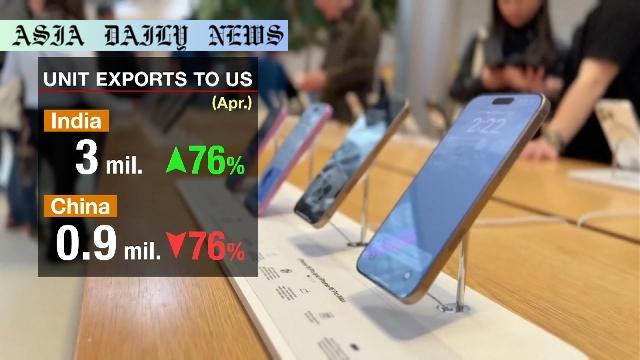iPhone shipments surged as India surpasses China as top exporter to US, driven by new production strategies and tariff impacts.
- India overtakes China as the leading exporter of iPhones to the US.
- India shipped roughly 4.4M iPhones in March, beating China’s 4.3M.
- Apple aims to reduce tariff impacts through increased production in India.
- US-China tariffs drive India’s rise in iPhone manufacturing.

India Rises in iPhone Manufacturing, Surpassing China
In a significant shift in global manufacturing and trade dynamics, India has overtaken China as the leading exporter of iPhones to the United States. This change reflects a broader strategic maneuver by tech giant Apple to reduce its reliance on Chinese factories while mitigating the impact of US-imposed tariffs on Chinese imports. According to CNBC, citing data from Singapore-based research firm Canalys, Indian iPhone shipments soared to 4.4 million units in March 2023 compared to 4.3 million by China. This growth underlines India’s increasing importance as a manufacturing hub for Apple’s flagship products.
Key Drivers of the Shift
India’s growth as an iPhone manufacturing leader is more than just a statistical achievement; it is the result of deliberate policy decisions and market strategies. The US-China trade conflict, particularly the imposition of tariffs on Chinese goods, has forced multinational firms like Apple to reevaluate their production strategies. India has seized this opportunity by offering competitive advantages such as affordable labor costs, favorable trade policies, and growing manufacturing infrastructure.
Future Projections and Implications
Apple CEO Tim Cook recently highlighted that most iPhones available for US customers during the April-to-June 2023 quarter would be manufactured in India. Exceeding China’s shipments demonstrates not only India’s capabilities but also a potentially transformative trend for global trade and technology manufacturing. However, challenges remain, including potential tariff threats from former US President Donald Trump. Despite these uncertainties, India’s favorable conditions seem to ensure its continued growth as a key player in the global tech manufacturing landscape.



Commentary
India’s Strategic Advantage
India’s emergence as the leading iPhone exporter to the United States is a fascinating testament to how geopolitical and economic factors can reshape manufacturing landscapes. For decades, China has dominated tech production, benefiting from its massive scale, advanced infrastructure, and efficient supply chain management. However, the US-China trade tensions have opened opportunities for other nations, and India has smartly seized this moment to position itself as a viable, cost-effective alternative.
Apple’s Masterstroke
Apple’s pivot to India is not just a reactive measure to mitigate tariffs but a proactive strategy in diversifying its manufacturing base. By investing heavily in India, Apple ensures continuity in production, minimizes risks, and leverages the country’s burgeoning workforce and expanding industrial capacity. This move also aligns with Apple’s broader goal of creating a robust, decentralized supply chain that is less vulnerable to regional disruptions, whether they stem from trade wars, pandemics, or other geopolitical uncertainties.
The Road Ahead
While the surge in iPhone shipments from India is undeniably impressive, sustaining this momentum will require continuous efforts from all stakeholders. The Indian government must continue to enhance its infrastructure, streamline regulations, and build an ecosystem conducive to high-tech manufacturing. On the other hand, Apple needs to address operational challenges and invest in training and upskilling its workforce to sustain quality standards and efficiency. If successful, this partnership between Apple and India could set a precedent for other global companies seeking alternatives to China’s manufacturing dominance.